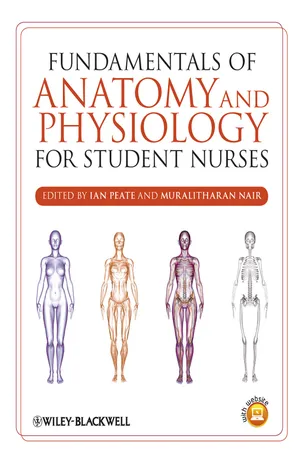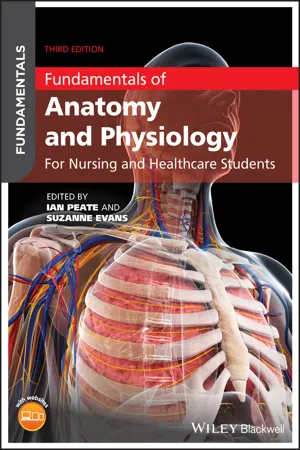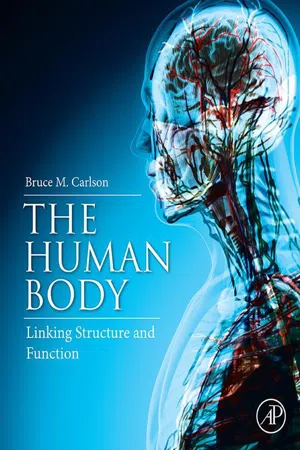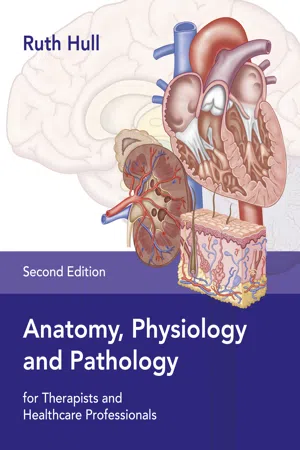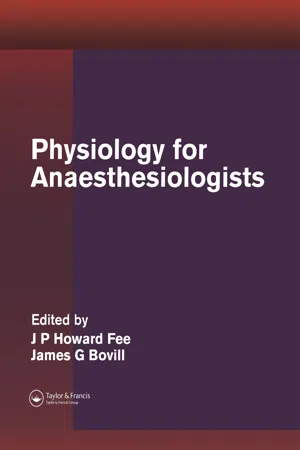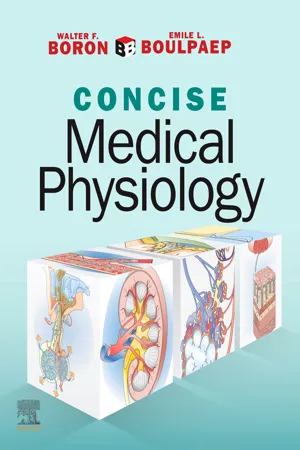Psychology
The Function of the Endocrine System - Glands and hormones
The endocrine system is a network of glands that produce and release hormones, which regulate various bodily functions such as metabolism, growth, and mood. Glands like the pituitary, thyroid, and adrenal glands secrete specific hormones that travel through the bloodstream to target organs, where they exert their effects. This system plays a crucial role in maintaining homeostasis and responding to stress.
Written by Perlego with AI-assistance
Related key terms
11 Key excerpts on "The Function of the Endocrine System - Glands and hormones"
- eBook - ePub
Fundamentals of Children and Young People's Anatomy and Physiology
A Textbook for Nursing and Healthcare Students
- Ian Peate, Elizabeth Gormley-Fleming(Authors)
- 2021(Publication Date)
- Wiley-Blackwell(Publisher)
Figure 11.1 .The endocrine system.Figure 11.1Source: Illustration from Anatomy & Physiology, Connexions Web site. http://cnx.org/content/col11496/1.6/ , Jun 19, 2013. Licensed under Attribution 3.0 Unported (CC BY 3.0).The integrity and health of the endocrine system are essential to maintaining healthy body weight, growth and both physical and emotional development. The endocrine system significantly affects children and young people who are experiencing a high rate of development, and different parts of this system play a role as ageing occurs.Hormones are major systemic regulators of homeostatic functions (Neumann et al., 2019). Their effects are varied and many which can be categorised into four broad areas as relevant to the developing child:- They play a role in the sequential integration of growth and development.
- They contribute to basic processes of reproduction, starting as early as gamete formation, fertilisation, stability of the growing fetus, labour and the subsequent adaptation to extrauterine life.
- They help to control the internal environment throughout life by regulation and homeostasis of many physiological functions.
- They respond to changes in environmental conditions to assist the body to cope with emergency demands, such as stress, trauma, dehydration and temperature imbalances (Greenstein and Wood, 2011; Waugh and Grant, 2018).
Physiology of the endocrine system
The endocrine system works alongside the nervous system to control many vital functions of the body. The nervous system provides a very fast and narrowly targeted system to act on specific glands and muscles throughout the body. The endocrine system, on the other hand, is much slower acting, but has very widespread, long‐lasting and powerful effects. Hormones are distributed by glands through the bloodstream to the entire body, affecting any cell with a receptor for a particular hormone (Molina, 2018). Whilst the two systems are different in these specific ways, it is important to remember how they also work together to affect cells in several organs or tissues throughout the entire body, leading to many potent and diverse responses. Overall, the two systems work together closely to coordinate their activities in an integrated way. When a gland in the endocrine system releases a hormone, it travels via the bloodstream to a target area where it exerts its effect. Hormones are designed to interact with a specific part of the body, so when the hormone arrives at this organ or tissue, a particular action takes place (Williams and Hopper, 2019). - Ian Peate, Muralitharan Nair(Authors)
- 2011(Publication Date)
- Wiley-Blackwell(Publisher)
The nervous system reacts rapidly to stimuli and effects its changes over a period of seconds or minutes, thus it is involved in the immediate and short-term maintenance of homeostasis. Due to its rapid onset of action the nervous system is responsible for the control of rapid bodily processes such as breathing and movement. The endocrine system is often responsible for the regulation of longer-term processes. The major functions it coordinates are:- Homeostasis–maintains the internal body environment
- Storage and utilisation of energy substrates (carbohydrates, proteins and fats)
- Regulation of growth and reproduction
- Control ofthe body’s responses to external stimuli (particularly stress).
The endocrine system is made up of a collection of small organs that are scattered throughout the body, each of which releases hormones into the blood supply ( ‘endo’ &= within, ‘crine’ &= to secrete). These hormone-releasing organs can be split into three main categories (Jenkins et al. 2007):- Endocrine glands, organs whose only function is the production and release of hormones. These include:
- pituitary gland
- thyroid gland
- parathyroid gland
- adrenal gland
- Organs that are not pure glands (as they have other functions as well as the production of hormones) but contain relatively large areas of hormone producing tissue. These include:
- eBook - ePub
Fundamentals of Anatomy and Physiology
For Nursing and Healthcare Students
- Ian Peate, Suzanne Evans(Authors)
- 2020(Publication Date)
- Wiley-Blackwell(Publisher)
The nervous system reacts rapidly to stimuli and effects its changes over a period of seconds or minutes; thus, it is involved in the immediate and short‐term maintenance of homeostasis. Owing to its rapid onset of action, the nervous system is responsible for the control of rapid bodily processes such as breathing and movement. The endocrine system is often responsible for the regulation of longer term processes. The major functions it coordinates are- homeostasis – maintains the internal body environment;
- storage and utilisation of energy substrates (carbohydrates, proteins and fats);
- regulation of growth and reproduction;
- control of the body’s responses to external stimuli (particularly stress).
The endocrine system is made up of a collection of small organs that are scattered throughout the body, each of which releases hormones into the blood supply (‘endo’ = within, ‘crine’ = to secrete). These hormone‐releasing organs can be split into three main categories (Jenkins and Tortora, 2013 ).- Endocrine glands – organs whose only function is the production and release of hormones. These include:
- pituitary gland
- thyroid gland
- parathyroid gland
- adrenal gland.
- Organs that are not pure glands (as they have other functions as well as the production of hormones) but contain relatively large areas of hormone‐producing tissue. These include:
- hypothalamus
- pancreas.
- Other tissues and organs that also produce hormones – areas of hormone‐producing cells are found in the wall of the small intestine and the stomach.
There are no cell types, organs or processes that are not influenced by the endocrine system in some way and while there are many hormones that we know of there are probably many more that are yet to be discovered.The Endocrine Organs
Figure 16.1 shows the endocrine organs and their position within the body. Each of these organs will typically have a rich blood supply delivered by numerous blood vessels. The hormone‐producing cells within the organ are arranged into branching networks around this supply. This arrangement of blood vessels and hormone‐producing cells ensures that hormones enter the bloodstream rapidly and are then transported throughout the body to the target cells (see Figure 16.2 - Laurie K. McCorry, Martin M. Zdanowicz, Cynthia Yvon Gonnella(Authors)
- 2021(Publication Date)
- Routledge(Publisher)
There are two major regulatory systems that are the main contributors to homeostasis: the nervous system and the endocrine system. To maintain relatively constant conditions in the internal environment of the body, each of these systems influences the activity of all the other organ systems. Using electrical impulses, the nervous system coordinates rapid, precise responses, such as muscle contractions. However, the effects of the nervous system’s impulses are of short duration (milliseconds). Unlike the nervous system, the endocrine system regulates metabolic activity within the cells of the organs and tissues and coordinates activities that require longer duration (hours, days), rather than speed. Examples of such activities include growth, the long-term regulation of plasma volume and blood pressure, and the coordination of menstrual cycles in females.The endocrine system carries out its effects through the production of hormones, chemical messengers that exert a regulatory effect on the cells of the body. Secreted from endocrine glands, which are ductless structures, hormones are released directly into the blood. They are then transported by the circulation to the tissues upon which they exert their effects. Because they travel in the blood, the serum concentrations of hormones are very low (10−11 to 10−9 M); therefore, these molecules must be very potent.This chapter will consider the hormones secreted from several endocrine glands including the pituitary, thyroid, parathyroid, and adrenal glands, as well as the pancreas. It is important to note, however, that hormones may be secreted from organs and tissues whose primary functions are not endocrine in nature. For example, the hypothalamus synthesizes and releases many hormones that influence the secretion of hormones from the anterior pituitary gland. In addition, the hypothalamus synthesizes the hormones that are subsequently released from the posterior pituitary gland. Other tissues and their hormones include the following:- William O. Reece, Eric W. Rowe(Authors)
- 2017(Publication Date)
- Wiley-Blackwell(Publisher)
CHAPTER 6 Endocrine SystemCHAPTER OUTLINE
-
HORMONES
- Modes of Transmission
- Biochemistry
-
PITUITARY GLAND
- Anterior Pituitary
- Anterior Pituitary Hormones
- Posterior Pituitary and Its Hormones
-
THYROID GLAND
- Thyroid Hormones
-
PARATHYROID GLANDS
- Parathyroid Hormone and Calcium Ion Regulation
-
ADRENAL GLANDS
- Hormones of the Adrenal Cortex
- Glucocorticoid Functions and Regulation
- Mineralocorticoid Functions and Regulation
- Hormones of the Adrenal Medulla
-
PANCREATIC GLAND
- Hormones of the Pancreas
- Control of Insulin and Glucagon Secretion
- PROSTAGLANDINS AND THEIR FUNCTIONS
The endocrine system is considered to be one of the animal body’s communication systems and its products (the hormones) help send messages to other cells. The other communication system is the nervous system, in which nerve networks conduct messages from cells in one part of the body to cells in another part. The nervous system uses physical structures (neurons) to transmit messages (impulses), but the endocrine system uses the body fluids (humors) as its medium to transmit messages (hormones). Because of this, control by the latter system is referred to as humoral control, in contrast to neural control.The principal function of neural and humoral communication is control or regulation of various body functions. Nerve impulses traveling from the brain to the heart by way of the vagus nerve assist in the control of heart activities. Similarly, thyroid hormones are released from thyroid gland cells and circulated by the blood and interstitial fluids to all cells of the body to assist in the regulation of metabolic rate.- eBook - ePub
- Patricia Barnes-Svarney, Thomas E. Svarney(Authors)
- 2016(Publication Date)
- Visible Ink Press(Publisher)
INTRODUCTION What are the functions of the endocrine system?The endocrine system, together with the nervous system, controls and coordinates the functions of all of the human body systems. The endocrine system helps to maintain homeostasis and metabolic functions, allows the body to react to stress, and regulates growth and development, including sexual development.What are the similarities between the nervous system and the endocrine system?Both the nervous system and endocrine system are devoted to maintaining homeostasis by coordinating and regulating the activities of other cells, tissues, organs, and systems. Both systems are regulated by negative feedback mechanisms. Chemical messengers are important in both systems, although their method of transmission and release differs in the two systems.How does the endocrine system differ from the nervous system?Both the endocrine and nervous systems are regulatory systems that permit communication between cells, tissues, and organs. A major difference between the endocrine system and nervous system is the rate of response to a stimulus. In general, the nervous system responds to a stimulus very rapidly, often within a few milliseconds, while it may take the endocrine system seconds and sometimes hours or even days to offer a response. Furthermore, the chemical signals released by the nervous system typically act over very short distances (a synapse), while hormones in the endocrine system are generally carried by the blood to target organs. Finally, the effects of the nervous system generally last only a brief amount of time, while those of the endocrine system are longer lasting. Examples of endocrine control are growth and reproductive ability.The endocrine system. What are the organs of the endocrine system?The endocrine system consists of glands and other hormone-producing tissues. Glands are specialized cells that secrete hormones into the interstitial fluid. Hormones are then transported to the capillaries and circulated via the blood. The major endocrine glands are the pituitary, thyroid, parathyroid, pineal, and adrenal The endocrine system. glands. Other hormone-secreting organs are the central nervous system (hypothalamus), kidneys, heart, pancreas, thymus, ovaries, and testes. Some organs, such as the pancreas, secrete hormones as an endocrine function but have other functions also. - eBook - ePub
The Human Body
Linking Structure and Function
- Bruce M. Carlson, Bruce M. Carlson(Authors)
- 2018(Publication Date)
- Academic Press(Publisher)
Chapter 9The Endocrine System
Abstract
Hormones act on cells by binding to surface or intracellular receptors and then eliciting a specific response from these cells. Much of the endocrine system is organized in a hierarchical fashion, with releasing hormones of the hypothalamus controlling secretions of the adenohypophysis, and stimulating hormones of the adenohypophysis controlling release of hormones from the thyroid, adrenal cortex, and gonads. The neurohypophysis is a neurosecretory organ. At all levels, secretions are controlled by inhibitory feedback loops from downstream endocrine organs. Signals from higher brain centers can exert a profound effect on endocrine secretions. Female reproductive cycles, in particular, are tightly controlled by hormones produced by both the adenohypophysis and the ovaries. In turn, steroid hormones produced in the ovaries modulate secretions of both the hypothalamus and pituitary.Keywords
Endocrine glands; evolution; paracrine and autocrine secretion; steroid hormones; protein hormones; hypothalamus; pituitary gland; adenohypophysis; neurohypophysis; adrenal cortex; adrenal medulla; thyroid gland; parathyroid gland; ovary; testis; hypothalamic–pituitary–adrenal axis; releasing hormones; islets of Langerhans; reproductive cyclesThe more we learn about the human body, the more we realize how interconnected and how integrated are most bodily functions. Obvious examples of whole-body interconnectedness are the nervous and circulatory systems because of their structural organization and distribution. Other interconnections are more subtle. The connective tissue linkages throughout the body are very structural, but their importance in the overall functioning of the body has only recently been generally recognized. Another set of linkages—the hormones produced by the endocrine glands—is principally chemical, but through the mediation of both the circulatory and nervous systems, endocrine secretions reach almost every cell of the body. - eBook - ePub
- Ruth Hull(Author)
- 2021(Publication Date)
- Lotus Publishing(Publisher)
7 The Endocrine System IntroductionWhy is it that some people are exceptionally tall while others are small? Or some people can have children while others can’t? What is it that controls such processes in our bodies? It is the same system that controls our blood pressure, immune system, metabolism and even our response to danger. It is the endocrine system.The study of the glands and hormones of the endocrine system is endocrinology . In this chapter you will learn about the endocrine system and discover how it works together with your nervous system to control all the other systems of your body.Student objectives By the end of this chapter you will be able to:• Describe the functions of the endocrine system• Describe the organisation of the endocrine system• Explain what a hormone is and how it works• Identify the differences between the nervous and endocrine systems• Describe the endocrine glands and the hormones they produce• Identify the common pathologies of the endocrine system.Did you know?Before looking at the functions of the endocrine system, it helps to understand exactly what endocrine glands and hormones are. There are two types of glands in the body: exocrine and endocrine.The endocrine glands are not the only tissues in the body that secrete hormones. The kidneys, stomach, liver, small intestine, skin, heart and placenta also contain cells that secrete small amounts of hormones.• Exocrine glands: These secrete substances into ducts that carry the substances into body cavities or to the outer surface of the body. Examples of exocrine glands include sudoriferous (sweat), sebaceous (oil), mucous and digestive glands.• Endocrine glands: These secrete substances into the extracellular space around their cells. The secretions then diffuse into blood capillaries and are transported by the blood to target cells located throughout the body. Substances secreted by endocrine glands are called hormones - eBook - ePub
- F. Robert Brush, Seymour Levine(Authors)
- 2013(Publication Date)
- Academic Press(Publisher)
CHAPTER SEVENPsychoneuroendocrinology of Stress: A Psychobiological Perspective
Seymour Levine, Christopher Coe and Sandra G. WienerPublisher Summary
This chapter discusses specific psychological variables that are involved in the regulation of the Pituitary–Adrenal (P–A) activity and specific aspects of the psychological variables that can selectively affect and regulate the secretion of gonadal hormones. The influence of psychological factors on P–A hormones is bidirectional. The psychological stimuli not only participate in activating this system but also effectively inhibit it. This inhibition is manifested either by reduced elevations of plasma corticoids during aversive stimulation or by an actual decrease in circulating levels of corticoids. This effect is particularly pronounced when the predictable or reinforcing stimulus involves consummatory events. Apart from induced stress, feedback is another factor involved in this process. Feedback refers to stimuli or information occurring after a behavioral response has been made in reaction to an event. These stimuli may be used to convey information to the responding organism indicating that it has made the correct response to a noxious event. The field of neuroendocrinology has made tremendous advances in the past few decades in identifying many chemical substances that qualify as hormones not only in the pituitary and peripheral organs but also in the central nervous system.I Introduction
Despite numerous and valiant attempts to define stress, a clear and universally accepted definition still remains, to say the least, elusive. It is not the purpose of this chapter, therefore, to dwell extensively on the problems related to the definition of stress. This would be an exercise in futility. It is important to note, however, that historically the concept of stress has always been associated with changes in the endocrine system. Initially, these changes were specifically related to either increased secretion of catecholamines or activation of the pituitary–adrenal (P–A) system. It has now been clearly demonstrated that many endocrine changes occur following those environmental events which are typically called stressful. The focus of a great deal of research related to stress physiology is still on the P–A system. It is, of course, impossible to discuss any facet of the P–A system and its relationship to environmental factors without acknowledging the landmark contributions of Hans Selye. His formulation of the General Adaptation Syndrome (GAS) highlighted the importance of this hormonal system and the diversive physiological effects of glucocorticoids following adverse stimulation (Selye, 1950 - eBook - ePub
- J.P. Howard Fee, James G. Bovill(Authors)
- 2004(Publication Date)
- CRC Press(Publisher)
7 The endocrine system
William FM WallaceDEFINITION AND SCOPE
Endocrine glands are distinguished from exocrine glands because they secrete within the body (endo) rather than out of the body (exo). The hormones that they secrete pass via the circulation to produce an effect by acting on target organs. This chapter considers the hormones most relevant to anaesthetic practice: insulin, thyroid hormones, hormones of the adrenal cortex and medulla, and parathormone. Within this framework, other hormones and influences are also considered, since the body’s responses are always complex. Thus glucose metabolism during intensive care is influenced by such hormones as insulin, glucagon, cortisol, and thyroxine, as well as autonomic nerves and local factors in damaged tissues.The next part of the chapter looks at the question, ‘Why an endocrine system?’, and at the end of the chapter the stress response is examined to illustrate the complex interactions of the endocrine, nervous, and cytokine systems. A notable example of such interactions is given by the sympathetic activating response, evoked in ‘fight and flight’ situations. Here the sympathetic nerves produce skin pallor, sweating, tremor, and tachycardia. At the same time, preganglionic sympathetic neurones activate the adrenal medulla to release large amounts of adrenaline and smaller amounts of noradrenaline and related hormones of the catecholamine family. Finally, if the response is prolonged, noradrenaline released as a neurotransmitter accumulates in the circulation to act together with the hormonal noradrenaline from the adrenal medulla—a neurotransmitter has become a hormone.In recent decades, many other chemicals have been discovered, that add to the transmitter/ hormonal cocktail in the circulation. Some are released and act on the releasing cell itself (autocrines) or on nearby cells (paracrines). Others are released from individual cells, particularly white blood cells, act locally and also enter the circulation to act in many respects like hormones—the cytokines. - eBook - ePub
Boron & Boulpaep Concise Medical Physiology E-Book
Boron & Boulpaep Concise Medical Physiology E-Book
- Walter F. Boron, Emile L. Boulpaep(Authors)
- 2020(Publication Date)
- Elsevier(Publisher)
Section VIII The Endocrine SystemOutlineChapter 47. Organization of Endocrine ControlChapter 48. Endocrine Regulation of Growth and Body MassChapter 49. The Thyroid GlandChapter 50. The Adrenal GlandChapter 51. The Endocrine PancreasChapter 52. The Parathyroid Glands and Vitamin DPassage contains an image
Chapter 47: Organization of Endocrine Control
Eugene J. BarrettMulticellular organisms evolved two major systems to communicate and to coordinate body functions:- 1. The nervous system integrates tissue functions by a network of cells and cell processes that constitute the nervous system and all subdivisions, as discussed in Chapters 10 through 16 .
-
2. The endocrine system integrates organ function via chemicals that are secreted from endocrine tissues or “glands” into the extracellular fluid. These chemicals, called hormones, are carried through the blood to distant target tissues, where they are recognized by specific high-affinity receptors. As discussed in Chapter 3 , these receptors may be located on the surface of the target tissue, within the cytosol, or in the target cell’s nucleus. These receptor molecules allow the target cell to recognize a unique hormonal signal from among the numerous chemicals that are carried through the blood and bathe the body’s tissues. The accuracy and sensitivity of this recognition are remarkable in view of the very low concentration (10− 9to 10− 12M) at which many hormones circulate.
Once a hormone is recognized by its target tissue or tissues, it can exert its biological action by a process known as signal transduction (see Chapter 3
Index pages curate the most relevant extracts from our library of academic textbooks. They’ve been created using an in-house natural language model (NLM), each adding context and meaning to key research topics.

